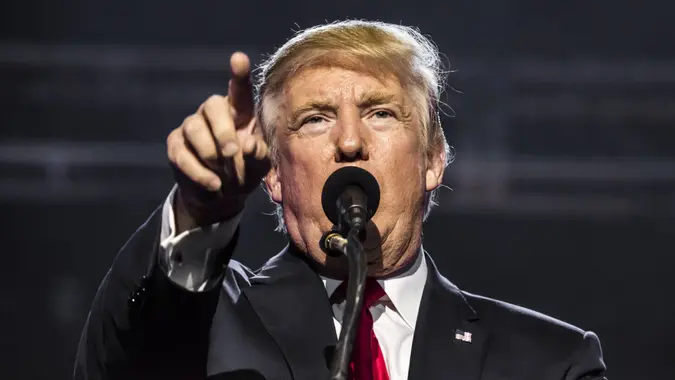5 Things That Could Actually Get Cheaper With Trump’s Tariffs

Commitment to Our Readers
GOBankingRates' editorial team is committed to bringing you unbiased reviews and information. We use data-driven methodologies to evaluate financial products and services - our reviews and ratings are not influenced by advertisers. You can read more about our editorial guidelines and our products and services review methodology.

20 Years
Helping You Live Richer

Reviewed
by Experts

Trusted by
Millions of Readers
Recently, much attention has been focused on the rising costs linked to President Donald Trump’s tariff announcements. But what about the potential for prices to drop? While many highlight the added costs of imported products, some industries may actually end up offering more affordable options due to reduced foreign competition or revitalized domestic production.
Some of these projections lay further ahead in the future, but let’s explore the goods that could become cheaper amid the ongoing trade war — and how consumers might benefit from the tariffs.
Gas
Crude oil prices have plunged to a four-year low following President Trump’s new tariffs on U.S. trading partners, as Foxed Business Network reported. This dramatic drop in global oil costs is expected to translate into direct savings for American drivers, with gas prices projected to decline steadily in the coming weeks.
Industry experts note that the tariffs are disrupting traditional supply chains, forcing a recalibration in energy markets that could lead to sustained lower prices. Some forecasts suggest gasoline prices may fall by as much as 15 cents per gallon in the near term, potentially making this the cheapest summer at the pump since the COVID-19 pandemic began.
Beef
While the new tariffs will likely drive up prices for imported goods like seafood, coffee and exotic fruits, analysts point to an unexpected silver lining: the U.S. beef industry could experience a “price positive” effect, according to Drovers — a beef industry news magazine. This counterintuitive outcome is a result of tariffs altering competitive dynamics. By making imported beef more expensive, the policies effectively reduce foreign participation in the domestic meat market.
With fewer imports entering the country, U.S. beef supplies are expected to tighten. This constrained supply — in combination with a consistent consumer appetite for beef-could empower American cattle producers to stabilize or even improve prices for their livestock.
Lumber
The Trump administration’s new executive order mandates a 25% increase in timber harvesting from federal lands, signaling a major expansion of domestic lumber production. This policy shift aims to reduce America’s reliance on imported wood by streamlining regulations and accelerating permitting.
While the full effects may take years due to sawmill capacity constraints, the increased supply could eventually help stabilize and potentially lower lumber prices for builders and consumers, according to the National Association of Home Builders (NAHB). The move comes as tariffs on Canadian lumber are set to rise sharply in the near future.
Wooden Furniture
Some industry leaders argue that tariffs could catalyze a revival in U.S. wooden furniture manufacturing, according to Furniture Today. Large-scale domestic manufacturers, which already rely heavily on American-sourced materials (often 95% or more), stand to gain the most from reduced import competition.
Though regulatory hurdles, such as lengthy permitting processes for new facilities, remain a challenge, proponents emphasize that the U.S. workforce and supply chains are capable of supporting growth. By rebalancing production costs in favor of domestic operations, the tariffs could make American-made furniture more competitive on price, particularly for mid-range and premium products.
Clothing
While new tariffs are driving up prices for imported clothing, domestically manufactured apparel could become relatively cheaper by comparison, according to GQ. Since American-made garments aren’t subject to these import taxes, they may gain a competitive price advantage.
Some industry experts suggest this could boost demand for U.S. production and if domestic manufacturing expands sufficiently, it might eventually lead to lower prices for consumers. The long-term effect could make some American-Made clothing more affordable.
Editor’s note on political coverage: GOBankingRates is nonpartisan and strives to cover all aspects of the economy objectively and present balanced reports on politically focused finance stories. You can find more coverage of this topic on GOBankingRates.com.
More From GOBankingRates
 Written by
Written by  Edited by
Edited by 

























